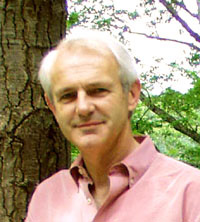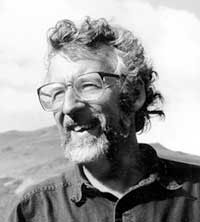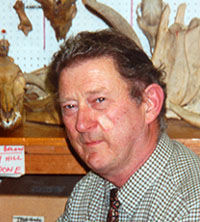ANDREW MOORE
 Born and raised in Devon, Moore gained early experience of
archaeological fieldwork as a teenage volunteer on excavations of sites
of many periods in the West of England. At Oxford he read Modern
History, and participated in digs organized by the Oxford University
Archaeological Society of which he became President. In 1966
he joined Kathleen Kenyon's excavation in Jerusalem, his first experience
of fieldwork in the Middle East. Postgraduate studies in archaeology at
the University of London, where he studied under Professor John
Evans, provided opportunities to participate in surveys and excavations
in Italy, Malta, and at Knossos on Crete. Moore then returned to Oxford
to pursue doctoral work with Kathleen Kenyon. His interests lay in the
beginning of farming and settled life in the Middle East. Supported by a
Randall MacIver Studentship and a Wainwright Fellowship from Oxford
among other honors, he embarked on extensive research of sites and
museum collections across the Middle East. His doctoral thesis entitled
The Neolithic of the Levant was completed in 1978.
Born and raised in Devon, Moore gained early experience of
archaeological fieldwork as a teenage volunteer on excavations of sites
of many periods in the West of England. At Oxford he read Modern
History, and participated in digs organized by the Oxford University
Archaeological Society of which he became President. In 1966
he joined Kathleen Kenyon's excavation in Jerusalem, his first experience
of fieldwork in the Middle East. Postgraduate studies in archaeology at
the University of London, where he studied under Professor John
Evans, provided opportunities to participate in surveys and excavations
in Italy, Malta, and at Knossos on Crete. Moore then returned to Oxford
to pursue doctoral work with Kathleen Kenyon. His interests lay in the
beginning of farming and settled life in the Middle East. Supported by a
Randall MacIver Studentship and a Wainwright Fellowship from Oxford
among other honors, he embarked on extensive research of sites and
museum collections across the Middle East. His doctoral thesis entitled
The Neolithic of the Levant was completed in 1978. In 1971 Moore was invited by the Syrian authorities to select a prehistoric site for excavation in the sector of the Euphrates Valley threatened by the construction of a new dam. He chose Abu Hureyra. The results of the excavation were potentially so significant that, in partnership with Hillman and Legge, he has devoted much of his subsequent career to exploring the implications of the data from Abu Hureyra for the transition from foraging to farming. That research has decisively demonstrated that agriculture began much earlier in the Euphrates Valley than had been suspected and that Abu Hureyra played a key role in its development. The site has illuminated the dramatic immediate results of the adoption of farming with unusual clarity.
Moore's archaeological interests span the Middle East, the Mediterranean, and Europe. His research has concentrated on the advent of agriculture and sedentary life in Western Asia and their spread to adjacent continents, but he also works on the development of complex societies and town life in the Middle East. In this connection Moore has conducted field research in Turkey and Iraq as well as in Syria. His interests extend through the theory and practice of archaeology and the application of advances in the natural sciences to understanding the past. Currently, he is co-directing the Early Farming in Dalmatia Project, an investigation of the spread of farming to the Central Mediterranean from Western Asia. Moore has taught archaeology in the departments of anthropology at the University of Arizona and Yale University. At Yale he also served as Associate Dean in the Graduate School of Arts and Sciences. Moore is currently Dean Emeritus of the College of Liberal Arts and of Graduate Studies and Professor Emeritus at the Rochester Institute of Technology.
Curriculum Vitae
GORDON HILLMAN
 Hillman
started his career working in nursery gardening, the family
business, but he was already a committed naturalist with a detailed
knowledge of the British flora. He joined the United Kingdom's Nature
Conservancy at their Alston Moor nature reserve, and thereafter the
Botany Department of London's Natural History Museum where he worked
for five years on European floras. His university education was in
agricultural botany at the University of Reading where he developed his
special interests in evolutionary genetics and plant taxonomy.
Hillman
started his career working in nursery gardening, the family
business, but he was already a committed naturalist with a detailed
knowledge of the British flora. He joined the United Kingdom's Nature
Conservancy at their Alston Moor nature reserve, and thereafter the
Botany Department of London's Natural History Museum where he worked
for five years on European floras. His university education was in
agricultural botany at the University of Reading where he developed his
special interests in evolutionary genetics and plant taxonomy. It was his interests in the evolution of wheat that first led him into archaeology. Following research training in archaeobotany at the University of Mainz, Germany, and the Romisch-Germanisches Zentralmuseum, he became Research Fellow at the British Institute of Archaeology at Ankara where he worked on early agriculture, field experiments to measure domestication rates in wild cereals under primitive cultivation, and ethnographic studies of traditional systems of crop husbandry. It was in Ankara that he first met Andrew Moore who invited him to participate in the Abu Hureyra project from its outset. There followed 25 years of research on the Abu Hureyra plant remains and on associated ecological studies in Syria and other areas of Southwest Asia where there were wild plant communities, complete with key plant foods, analogous to those likely to have existed at Epipalaeolithic Abu Hureyra. During this time, Hillman worked in the Botany Department of University College, Cardiff, Wales, and served as Archaeobotanist to the Welsh Archaeological Trusts. Later, he joined the Department of Human Environment at the Institute of Archaeology, University College London, which allowed a period of unbroken research on the Abu Hureyra plant remains and related laboratory and field ecological studies. At the Institute of Archaeology Hillman taught courses in archaeobotany (palaeo-ethnobotany) and related areas. Now in retirement, he is Professor Emeritus in Archaeobotany. His particular interest is in hunter-gatherer ethnobotany in temperate and arid zones world wide. With the survival expert Ray Mears, he has researched probable past patterns of use of wild plant foods in aboriginal (pre-agrarian) Britain.
ANTHONY LEGGE 1939-2013 ✝
 Tony Legge began work as a technician in a research laboratory that was concerned
with the environmental physiology of domestic mammals. A brief spell
of military conscription during the time that the Berlin Wall went up
induced a determination to spend the future working on the past - an
increasing interest. In 1966 he joined Eric Higgs' excavation at the
Asprochaliko shelter in Epirus, Greece, and then later that year he
entered Churchill College, Cambridge as a mature student. During his
undergraduate years Legge continued to excavate with Eric Higgs in Epirus
each summer and, after graduation in 1969, he joined the research project
on the early history of agriculture at Cambridge University, which was
funded by the British Academy, with Eric Higgs as Director. However,
his suggestion that the project name be changed to Economic and Socio-Historic
Investigations of Grain Growing Societies (ESHIGGS) was not adopted.
Tony Legge began work as a technician in a research laboratory that was concerned
with the environmental physiology of domestic mammals. A brief spell
of military conscription during the time that the Berlin Wall went up
induced a determination to spend the future working on the past - an
increasing interest. In 1966 he joined Eric Higgs' excavation at the
Asprochaliko shelter in Epirus, Greece, and then later that year he
entered Churchill College, Cambridge as a mature student. During his
undergraduate years Legge continued to excavate with Eric Higgs in Epirus
each summer and, after graduation in 1969, he joined the research project
on the early history of agriculture at Cambridge University, which was
funded by the British Academy, with Eric Higgs as Director. However,
his suggestion that the project name be changed to Economic and Socio-Historic
Investigations of Grain Growing Societies (ESHIGGS) was not adopted.
Legge was jointly responsible for conducting the excavations at the site of Nahal Oren near Haifa, and with the development of water flotation and sieving methods for the recovery of charred plant remains with other members of the Cambridge research project. These techniques were used extensively at sites in Britain and elsewhere, showing how charred plant remains were preserved in abundance at most sites - even in those of the enigmatic British Neolithic period. About this time meetings with Andrew Moore and Gordon Hillman laid the foundations for the future excavation and retrieval strategy at Abu Hureyra. Work on the faunal remain from this site became his long-snding and major interest, and much work remains for this unique collection.
In 1974 Legge joined the staff of the University of London extension division, shortly after to be merged with Birkbeck College of London University, where in a 30 year career he became Professor of Environmental Archaeology. Legge's research interests centered on early farming societies in Cyprus, Serbia, and Spain, and on early Neolithic and other prehistoric sites in Britain. With Peter Rowley-Conwy (University of Durham) he published a new study of the faunal remains from the site of Star Carr in Yorkshire, England. Later in his career his interests expanded to include Jeitun in Turkmenistan, and Haua Fteah in Libya. In 2004 he joined Andrew Moore in the Early Farming in Dalmatia Project in Croatia, and undertook the analysis of the animal bones excavated from two Neolithic sites there, Pokrovnik and Danilo. He had a particular interest in the relationship between foraging and early farming communities. The broader transformation in human society and economy that concerned him above all was the inception of a farming way of life in Western Asia and its spread to Europe.
Tony Legge died in February 2013 after a short illness. We mourn the passing of a distinguished archaeozoologist, colleague and friend.